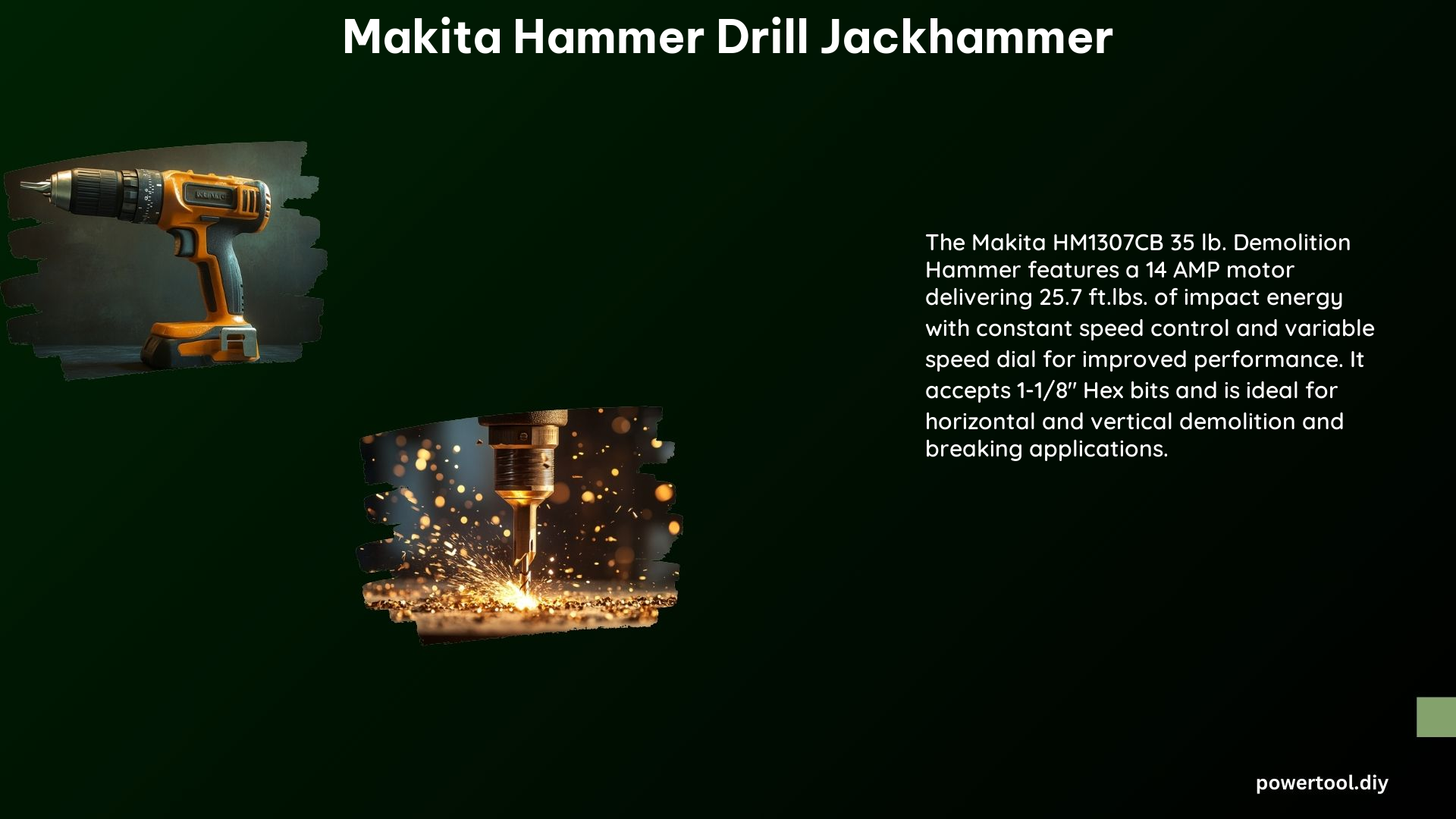The Makita HM1307CB 35 lb. Demolition Hammer is a powerful and versatile tool designed for demanding concrete, masonry, and demolition applications. With its 14-amp motor, variable-speed control, and robust construction, this hammer drill jackhammer delivers exceptional performance and durability.
Technical Specifications of the Makita Hammer Drill Jackhammer
- Power Source: 14-amp motor
- Voltage: 120 Volts
- Amperage: 14 Amps
- Maximum Chuck Size: 13 Millimeters
- Color: Blue
- Weight: 38.2 Pounds
- Dimensions: 12″L x 12″W x 12″H
- Material: Steel
- Maximum Power: 350 Watts
- Is Electric: Yes
- UPC: 088381604673
- Global Trade Identification Number: 00088381604673
- Manufacturer: Makita
- Part Number: HM1307CB
- Item Weight: 38.2 pounds
- Country of Origin: Japan
- Item model number: HM1307CB
- Is Discontinued By Manufacturer: No
- Style: Tool Only
- Wattage: 1510 watts
- Item Package Quantity: 1
- Special Features: Variable-speed
- Batteries Included?: No
- Batteries Required?: No
- Battery Cell Type: Lithium Ion
- Warranty Description: 1 year
Troubleshooting the Makita Hammer Drill Jackhammer

- Check Power Source:
- Ensure the tool is properly plugged into a stable and grounded power outlet.
- Check the circuit breaker or fuse to ensure the power source is functioning correctly.
-
Test the outlet with a voltage tester to confirm the presence of the correct voltage.
-
Inspect the Cord:
- Visually inspect the power cord for any signs of damage, such as cuts, fraying, or exposed wires.
- Gently flex the cord to check for internal damage that may not be visible on the surface.
-
Replace the cord if any damage is found to prevent electrical hazards and ensure safe operation.
-
Check the Chuck:
- Ensure the chuck is securely tightened and free of debris or obstructions.
- Inspect the chuck jaws for wear or damage and replace the chuck if necessary.
-
Verify that the chuck is compatible with the desired drill bits or accessories.
-
Check the Bits:
- Ensure the drill bits or demolition tools are properly seated and secured in the chuck.
- Inspect the bits for signs of wear, damage, or deformation, and replace them if necessary.
-
Use only high-quality, compatible bits designed for the specific application and the Makita hammer drill jackhammer.
-
Consult the Manual:
- Refer to the user manual for detailed troubleshooting steps and guidelines specific to the Makita HM1307CB model.
- The manual may provide information on common issues, recommended maintenance procedures, and contact details for Makita customer support.
Recommended Maintenance Procedures
- Regular Cleaning:
- Use a clean, dry cloth to wipe down the exterior of the tool, including the housing, vents, and chuck.
- Remove any accumulated dust, debris, or concrete particles from the tool’s surface and ventilation openings.
-
Avoid using water or liquid cleaners, as they may damage the tool’s internal components.
-
Lubricate Moving Parts:
- Apply a thin layer of high-quality, Makita-approved lubricant to the moving parts, such as the chuck and the piston mechanism.
- Refer to the user manual for the recommended lubricant type and application instructions.
-
Overlubrication can lead to issues, so follow the manufacturer’s guidelines carefully.
-
Check and Replace Brushes:
- Monitor the L.E.D. service/power indicator on the tool, which will alert you when the carbon brushes need replacement.
- Consult the user manual for the proper brush replacement procedure and ensure you use only genuine Makita replacement brushes.
-
Replacing worn brushes can help maintain the motor’s performance and prevent further damage.
-
Store Properly:
- Store the Makita hammer drill jackhammer in a dry, clean, and well-ventilated environment, away from direct sunlight or moisture.
- Avoid storing the tool in extreme temperatures, as this can affect the performance and lifespan of the internal components.
- If storing the tool for an extended period, consider covering it to protect it from dust and debris.
Common Problems and Solutions
- Motor Failure:
- Check for signs of overheating, such as discoloration or a burning smell, which may indicate a problem with the motor or its internal components.
- Inspect the carbon brushes for wear and replace them if necessary.
-
If the issue persists or you suspect a more complex electrical problem, consult a qualified Makita service center or a professional electrician for further diagnosis and repair.
-
Chuck Issues:
- Ensure the chuck is properly tightened and free of debris or obstructions.
- Check the chuck jaws for wear or damage and replace the chuck if necessary.
-
Verify that the chuck is compatible with the desired drill bits or accessories.
-
Bit Damage:
- Use only high-quality, Makita-approved bits that are designed for the specific application and the Makita hammer drill jackhammer.
- Inspect the bits for signs of wear, damage, or deformation, and replace them if necessary.
- Avoid using the tool for applications that exceed the bit’s recommended capacity or capabilities.
By following these troubleshooting steps and maintenance procedures, you can ensure the optimal performance and longevity of your Makita hammer drill jackhammer. Remember to always consult the user manual and contact Makita customer support if you encounter any issues that you are unable to resolve on your own.
